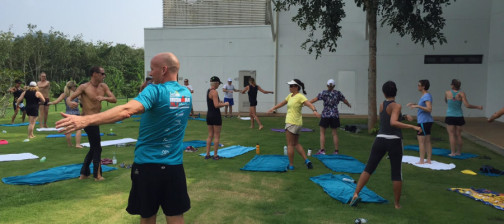This article has been written about the sport of triathlon, however, is applicable to all physical activities whether it be gym, cross fit, tennis etc.
We all want to become fitter, stronger and faster athletes right? It’s these goals that continuously drag us out bed at 5am, drive us to complete 10+ hours of training weekly, and withhold us from a night out because we don’t want to miss that all important Saturday morning session. We make sacrifices to be the best athlete we can be and will generally do anything to improve performance…. purchase a $2k disc wheel, latest Garmin, ride an extra 2hrs on a Saturday morning, swim an extra 400m to make a clean 4km, or purchase the latest running shoes to save 50g of weight and so on… sound familiar?
The desire and determination to improve performance can be a dangerous thing depending on how you look at it.
The typical question I am asked by athletes is “how do I become faster?”. They expect my response to be “train harder and more often”. This can be true in some cases like new athletes, however, for seasoned athletes who have plateaued, my response is “you need to move better to go faster”. They then look at me in disbelief in what they are hearing…. Putting it simply, good movement patterns = sound efficiency and performance.
For the large majority of age groupers, their mobility and stability is not allowing them to reach their potential. A typical analogy is imagining your body is a race car. The older we become the more damage we have endured and things start to break down. If the cars chassis is bent and the wheels are not aligned, going fast is going to be very difficult and consume allot of fuel. On top of this we will begin to see additional damage occur such as blown out tires an/or head gasket due to the added pressure on the car.
If we now apply this to the body you can see how poor posture and hip stability etc will lead to us to having poor efficiency, and ultimately cause an injury through compensation elsewhere.
Lets take a closer look at how mobility will improve efficiency and the 3 step continuum to moving better and becoming a stronger athlete:
1. MOBILITY AND RANGE
Triathletes are seen to generally have tight ankles, hips, shoulders and thoracic spine due to the large training load and minimal mobility work. These tight areas cause poor range and their movement patterns are limited.
Greater range will provide you more space to produce power and force, whilst allowing you to activate the correct muscle groups. Imagining only being able to hit a tennis or golf ball with half a swing… the power and force applied to the ball will be small.
From this analogy we can also understand how important mobility is for correct technique development and creating greater injury resistance.
Improving mobility and range can be done through:
- Deep tissue massage
- Trigger Point Tools such as spiky balls and rollers
- Stretching and mobilisation exercises prescribed by an Osteopath
View our blog ‘Making the most of your foam roller’
View our blog ‘Making the most of your spiky ball’
2. ACTIVATION AND STABILITY
Until the body has reasonable mobility, alignment and asymmetry’s are minimal, it’s going to be hard to correctly recruit the key muscle groups used for swim, bike and run and hold form for prolonged periods. For example, tight and weak hip flexors can cause poor pelvic stability and limit an athletes ability to activate and use the glutes. In this case it’s likely the back will take the load and begin to become painful; run form and efficiency will become poor and the athlete will fatigue = slower running.
Improving activation and stability:
During swim, bike and run, load transfer begins at the pelvis, and the deep stabilising core muscles of Transverse Abdominis and Multifidis provide us the stability we require for power transfer and efficiency. What many athletes don’t realise is completing high intensity core exercises such as sit ups and crunches will activate the larger mobilising core muscles, however, miss the muscles we actually require first to hold form. It’s important to ensure the stabilisers are working before targeting the mobilisers.
The exercises used to activate and strengthen these deep stabilising muscles are not hard and wont make you have a ripped 6 pack. They are more subtle and seen as neurological focus training and wiring the brain. This can certainly leave workhorse athletes feeling frustrated as they’re not fatiguing and sweating up a storm. Having an awareness of the muscles you are activating will lead to greater awareness during swim, bike and run.
3. STRENGTH
Strength endurance is the backbone to triathlon performance and being strong means you can produce force for extended periods of time. However, it’s no good doing the strength work if you are not going to do the mobility and activation first. If you are unable to recruit the stabilising muscles first, then your form will become poor and injury more likely.
Developing strength
There are many different ways to build strength and it doesn’t always mean hitting the gym. Although some gym exercises are fantastic, the reality is that many of us don’t have the time or resource to do this.
If you do have the time and access to a good strength trainer, then gym work can certainly be beneficial, especially for older athletes 40yrs+. The key when hitting the gym is to ensure the exercises you are completing are developing your movement as well as you strength.
Take a lunge for example, its a good strength exercise but is also generating mobility through your hips. Punching out bench press or bicep curls to improve your swimming are a waste of time and will have the reverse effect. Ask yourself, do I want to become a better athlete or look buff for the next festival?
For strength development I am a big fan of swim bike and run strength workouts such as pull, paddles and band for swimming, low cadence (55-60rpm) for cycling and shorter hill repeats and softer undulating surfaces/trails for the run. Strength workouts are particularly important for athletes aged 40+.
Unsure if your mobility and stability is holding you back?
Click here to subscribe to these mail outs and receive my favourite tests to see if you meet the minimum mobility standards.
If you would like any more information you can contact me at ryan@cfracing.com.au
Ryan Bourke
Triathlon Coach | CF Racing

